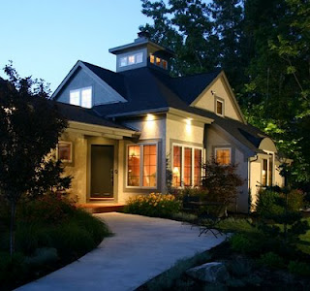
And you know you can’t afford that house because you’ve looked around and nobody’s building that cool house for less than a biodiesel-powered truckload of Krugerrands. Plan better – WAY better – and you can get what you want and keep those gold coins in your pocket.
Here are 7 ways to beat the high cost of construction and home improvement:
1. Smaller is smarter (really?)
The summit of obviousness, making a home smaller makes it less expensive. But random hacking away with a machete is the wrong approach we need a scalpel and a surgeon. So think carefully about redundancy why do you need a dining room AND a breakfast room AND five stools at the kitchen counter? A living room AND a study AND a family room AND a sitting area in the master suite?
Most of these uses can be combined into the same space one nice large place to eat, for example. Think about your furniture and how you arrange it when you don’t know how a room is going to be used you usually make it much too big. Carefully trim out the wasted, unused space and put the cash into that homey board-and-batten wainscot you love. Or lots and lots of chocolate.
2. Efficient use of building materials
Way back when, some really smart guys figured out that if building materials were all designed on a common module, they wouldn’t have to use or waste so much of it. So sheets of drywall and plywood are both 8 feet tall and 4 feet wide. Which works great on an 8-foot x 16-foot wall, but not so good when it’s 9.5-feet x 17 feet.
For the same reasons, structural lumber for floors comes from the mill in 2-foot increments. So whose idea was it to make rooms 13-feet wide? Design your house as much as possible on the established modules of building materials and stop filling the dumpster with scrap!
3. Use it where it counts, don’t use it where it doesn’t
I visited Steve Wynn’s Treasure Island Resort in Las Vegas a few years back and remember how impressed I was that the décor in the bathrooms in the furthest back corner of the casino was just as nice as the décor in the baths up front.
But Steve Wynn has a net worth of $2 billion. You probably don’t. So while I hope you become a billionaire, don’t spend like one just yet. Go ahead, put the granite countertops in the kitchen and the master bath, but not in the laundry room.
4. Design for low maintenance
This one sounds like a paradox: Spend more here to save more later. Cheap siding, roofing, and windows will cost you way more in the long run than quality components will now. There are entire industries built around the hope that you’ll buy replacement windows and a new roof for your house someday, probably much sooner than you think. Quality is the tortoise in this race. Do it right the first time.
5. Lower your energy bills – dramatically
This goes way beyond insulation, Argon-filled glass, and geothermal systems, and will be the subject of a lengthy article in the near future. In the meantime, don’t make the mistake of designing a home that isn’t climate- or site-specific and try to force it to be highly energy efficient – you’ll be addressing less than half the problem.
The real problem you need to solve is how your house DESIGN responds to the climate and the site. For example, don’t put a big wall of glass facing prevailing winter winds where the heat will get sucked out like a black hole.
Remember your 7th-grade geometry, how a square encloses the most area with the least perimeter. Remember how you thought you’d never need to know that? Turns out it comes in handy! So call up your old math teacher and tell her she can be proud because you’re going to use that knowledge in your house design. You’re going to enclose your new highly-efficient floor plan in a relatively square footprint and reduce your heat loss with fewer building materials!
6. Boxy is bee-you-tee-full
We have millions of really great-looking homes in this country, though most were built over 70 years ago. The designers and builders of the first American suburbs were experts at making simple homes elegant and attractive.
Good-looking homes are very often based on relatively simple box forms, properly proportioned, composed, and detailed.
Today, too many designers compensate for their lack of skill by loading the exteriors up with as much stuff as they can – gables, complex roof forms, heroic-scaled arched windows, inappropriate details, etc. Lots of money spent and nobody benefits but the home builder.
Keep the house forms simple and you’ll save a ton of green on the building materials. Look to the early 20th century suburbs for inspiration and lessons on the elegant simplicity of the box. You’ll have a better looking home that you can be proud of.
7. Good design sells
Speaking of good looking, energy-efficient, less expensive, low maintenance, smaller homes, guess what? They sell faster and for more money! Now that’s what I’m talkin’ about!!
My all-time favorite blow-my-own-horn story is of my client who (8 years later) sold his house in two weeks without a real estate agent – for twice what he paid to have it built. All he did was stick a sign out front. The buyer said it was the uniquely functional and interesting floor plan and irresistible exterior design that sold him on it.
No comments:
Post a Comment